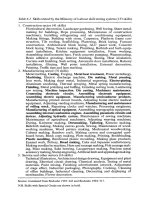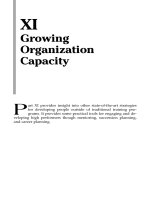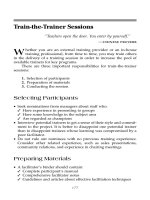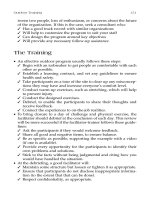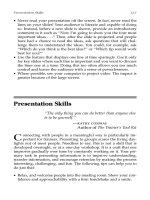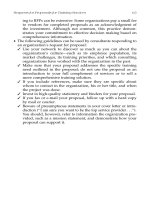The Trainer’s Tool Kit Second Edition phần 9 ppt
Bạn đang xem bản rút gọn của tài liệu. Xem và tải ngay bản đầy đủ của tài liệu tại đây (403.71 KB, 24 trang )
Train-the-Trainer Sessions
‘‘Teachers open the door. You enter by yourself.’’
—chinese proverb
W
hether you are an external training provider or an in-house
training professional, from time to time, you may train others
in the delivery of a training session in order to increase the pool of
available trainers for key programs.
There are three important responsibilities for train-the-trainer
sessions:
1. Selection of participants
2. Preparation of materials
3. Conducting the session
Selecting Participants
• Seek nominations from managers about staff who:
✓ Have experience in presenting to groups
✓ Have some knowledge in the subject area
✓ Are regarded as champions
• Interview potential trainers to get a sense of their style and commit-
ment to the project. It is better to disappoint one potential trainer
than to disappoint trainees whose learning was compromised by a
poor facilitator.
• Do not rule out nominees with no previous training experience.
Consider other related experience, such as sales presentations,
community relations, and experience in chairing meetings.
Preparing Materials
• A facilitator’s binder should contain:
✓ Complete participant’s manual
✓ Comprehensive facilitator notes
✓ Guidelines and articles about effective facilitation techniques
PAGE 177
177
10916$ $CH9 10-21-04 08:01:01 PS
178 Developing Trainers and Facilitators
✓ Complete set of overheads
✓ Complete set of handouts
✓ Copies of videos used during the training session
✓ Evaluation form used for the course
• In order to make the facilitator’s guide user friendly:
✓ Use symbols to denote flip chart, overhead, PowerPoint, and hand-
outs as they occur in the session.
✓ Use only the right-hand side of the manual for printed informa-
tion. Leave the left-hand side blank for notes.
✓ Integrate copies of overheads and handouts as they occur during
the session, so that users do not need to flip back and forth in
the manual.
✓ Include suggested responses for all exercises. Make the list as
comprehensive as possible.
✓ Include information and background data that will help facilita-
tors deal with some potentially difficult teaching principles.
✓ Lay out the manual as attractively as possible, and use bold type
so that the facilitator can see it easily at a comfortable distance.
✓ Use different colors to delineate the facilitator’s role and the par-
ticipants’ activities.
✓ Use well-marked dividers for each separate lesson or exercise.
Conducting the Session
• Review the key teaching principles and anticipated outcomes infor-
mally with participants before walking them through the manual.
• Discuss the group’s experiences as trainees (best and worst experi-
ences) as an aid to understanding the trainees’ perspectives.
• Review the manual and the lessons in digestible chunks, and de-
brief facilitators after each section.
• Conduct all role plays and exercises so that facilitators appreciate
the impact these will have on trainees.
• Assign facilitators to deliver individual sections to the group after
a comprehensive review of the manual. Allow them enough time
to prepare the lesson plans and to rehearse.
• Be constructive in debriefing facilitators about delivery glitches.
• Debrief each facilitator in private about his or her facilitator style
and technique.
PAGE 178
10916$ $CH9 10-21-04 08:01:02 PS
179Professional Development for Trainers and Facilitators
• Videotape some practice sessions, and let facilitators review their
own performances.
• Review evaluations from previous courses with the group to un-
derstand some major concerns and highlights of previous courses.
• Set up a hotline so that facilitators can contact you with urgent
issues during a course they are conducting.
• Send updates, amendments, and tips to facilitators during the
course delivery schedule.
• Prepare a list of facilitator names and contact details so they can
share advice with each other after conducting the course solo.
Professional Development for Trainers
and Facilitators
T
rainers and facilitators themselves can benefit from ongoing
skills development, feedback, and coaching. Internal leaders, ex-
ternal customers, and employees are redefining what they expect
from training.
Here are some inexpensive ways to support and encourage pro-
fessional development.
• Create mentoring partnerships between seasoned and less experi-
enced trainers; focus on developing one or two specific training
competencies.
• Set up learning forums with skilled presenters in the marketing,
sales, and public relations departments.
• Invite training vendors and consultants to discuss effective training
practices in other organizations they support.
• Convene a group of trainers to analyze feedback reports from key
courses to set action plans to increase the satisfaction ratings.
• Create partnerships with training teams in your industry or com-
munity to share best practices and resource material.
PAGE 179
10916$ $CH9 10-21-04 08:01:02 PS
180 Developing Trainers and Facilitators
• Obtain permission for trainers to audit courses in other organiza-
tions or local colleges to identify some effective techniques.
• Invite employees to a focus group to discuss good/bad facilitation
techniques based on their experiences.
• Arrange for trainers to make presentations at events that are out-
side their normal activities and comfort zones—for example, orien-
tation sessions, trade shows, or community events.
• Assign specific training topics to trainers who will develop and
present a short course for other trainers, for example:
✓ Handling difficult behavior
✓ Time management in the classroom
✓ Dealing with large groups
• Arrange opportunities for trainers to observe senior leaders present
to groups; debrief with the trainers about their observations and
lessons learned.
• Set up peer partnerships for trainers, who will observe each other
in the classroom and give specific feedback on strengths and weak-
nesses.
• Align trainers more closely with the business plan by:
✓ Visiting customer sites
✓ Meeting with senior leaders
✓ Shadowing an employee for a week to understand specific jobs
in more detail
✓ Facilitating team meetings in other parts of the organization
✓ Designing and conducting a training needs analysis
• Work with local chapters of training or human resources associa-
tions to develop a training skills curriculum; offer to pilot the
course at your organization in exchange for services and expertise.
• Partner with the local Toastmasters association to share techniques
and tips.
• Offer training support services to a community organization that
trains volunteers. (This will create goodwill for your organization
while trainers practice skills in a different environment.)
PAGE 180
10916$ $CH9 10-21-04 08:01:02 PS
181Professional Associations: A Checklist for Selecting and Joining
Professional Associations: A Checklist
for Selecting and Joining
Caveat Emptor (‘‘Buyer Beware’’)
P
rofessional associations keep trainers abreast of trends and help
to develop contacts for sharing information. The number of asso-
ciations is increasing as new training specializations emerge (for ex-
ample, multimedia).
• The primary benefits of joining an association are:
✓ Networking opportunities
✓ Professional development
✓ Access to up-to-date research
• Here are some guidelines in deciding which association(s) to join,
especially if affordability is an issue. Talk to employees of the asso-
ciation itself, as well as with your professional colleagues, and es-
tablish the following:
✓ Does membership entitle you to reduced conference fees? Are
the discounts significant?
✓ Does the association publish an annual member directory? This
is an important networking tool.
✓ Is there a local chapter?
✓ Does the local chapter meet regularly, and if so, how often?
✓ Do your professional colleagues recommend the association?
✓ Does the association publish a regular newsletter or magazine?
✓ Is the information the association provides relevant and inter-
esting?
✓ Is association information accessible on the Internet?
✓ Does the association provide specialized research on request, for
example, best practices, statistics, or case studies?
✓ Has the membership base increased annually?
✓ What percentage of members renews its membership annually?
✓ Are participant evaluation summaries available from previous
conferences and seminars?
✓ Who is the executive director of the association, and what are
his or her credentials?
PAGE 181
10916$ $CH9 10-21-04 08:01:03 PS
182 Developing Trainers and Facilitators
✓ Who are the board members of the association?
✓ What is the profile of the membership base: their experience lev-
els, industry groups, and so forth?
✓ Does the association set professional standards that are recog-
nized in the industry?
✓ Does the association conduct certification programs that are rec-
ognized in the industry?
✓ Are you treated with courtesy when you call in person or on the
telephone?
✓ Is there a resource center at the association office that members
can use?
✓ Does membership entitle you to discounts on training videos
and books?
✓ How does the cost of membership compare with other profes-
sional associations?
✓ How will joining a particular association support your own spe-
cific professional development interests?
• To reduce costs and maximize your opportunity to take advantage
of multiple memberships, consider:
✓ Sharing a membership with others in your organization
✓ Exchanging association literature with colleagues who have
joined other associations
✓ Using the Internet for information and advice
• Finally, if dollars are tight, consider forming an informal network-
ing group. Assign research projects to members, exchange interest-
ing articles, and share experiences.
PAGE 182
10916$ $CH9 10-21-04 08:01:03 PS
X
Sustaining the
Impact of Training
T
he impact of training dollars can be significantly increased if
conditions are created that encourage people to apply their
learning back on the job. Part X examines the role of the line
manager as a partner in this process.
PAGE 183
10916$ PT10 10-21-04 07:58:35 PS
This page intentionally left blank
Manager’s Role in Supporting Training
‘‘An organization attracts you to work there; only a
manager inspires loyalty.’’
—kathy conway
Author of The Trainer’s Tool Kit
M
anagers dispense rewards and punishments. They have more
control over the behavior and performance of employees than
anyone else. As such, their attitude toward learning and specific
courses will have a major impact on whether skills are transferred
back onto the job.
• Managers have three key roles vis-a
`
-vis training for their team
members:
1. Recommending specific training courses or activities and link-
ing them to the employee’s role and performance measures
2. Debriefing trainees on lessons learned and linking these lessons
to specific activities and opportunities
3. Conducting follow-up as new skills are applied through action
plans and feedback
• A manager also has responsibilities to the organization in support-
ing training’s overall effectiveness. These include:
✓ Recommending new or expanded training courses to meet busi-
ness challenges
✓ Recommending training course content that reflects the day-to-
day working environment, including case studies
✓ Providing realistic feedback about a course’s objectives and ef-
fectiveness after trainees have practiced new skills on the job
• Here are other ways that managers can strengthen the link between
training activities and organizational impact:
✓ Arrange for employees who have attended a training session to
present a short overview of key lessons to the team.
✓ Set up a ‘‘lending library’’ of training course manuals and litera-
ture for team members to use as reference guides.
✓ Create a customized feedback form for returning trainees to
complete that allows others on the team to prepare for the
course or to consider attending it.
PAGE 185
185
10916$ CH10 10-21-04 08:01:07 PS
186 Sustaining the Impact of Training
✓ Invite subject-matter experts to discuss some key lessons after a
team has attended a course.
✓ Compile lists of course-related reading materials and resources
that team members can reference after a course.
✓ Develop a code of conduct for the team that sets out expectations
for appropriate behavior while attending training—for example,
punctuality, cooperation, advance preparation, and so forth—
which ensures that time-off-the-job is well spent.
✓ Nominate specific employees as post-course ‘‘coaches’’ who can
assist recent trainees in applying new skills with confidence.
✓ Incorporate observations about an employee’s post-course train-
ing outcomes into the annual performance review.
✓ Create specialized projects that allow employees to practice and
assess new skills; solicit employee input about potential projects.
✓ Develop a post-training feedback agreement with individual
employees that focuses on applying key training outcomes.
• A manager must strive to model new skills that employees learn in
training. Managers should also point to others who practice a skill
well, as effective role-modeling behavior. It is unlikely employees
will apply new skills that are neither valued nor recognized.
Coaching for Skills Development
‘‘The focus is on helping an employee become
strong, not about making the employee feel better
about being weak.’’
—chip bell
Author of Managers as Mentors
T
he day-to-day interaction between the manager and employee
will have an enormous impact on the performance and behavior
of the employee. Having the manager act as a coach, using similar
strategies used in effective teamwork outside of the workplace, is a
useful starting point.
PAGE 186
10916$ CH10 10-21-04 08:01:08 PS
187Coaching for Skills Development
• Coaching for skills development is based on the same principles
that underlie all effective coaching, specifically:
✓ A formal or implied contract about the objective, and two-way
expectations and boundaries
✓ Observable behavior as a foundation for feedback
✓ Feedback that balances positive reinforcement with suggestions
for improvement
✓ Opportunities for demonstration and practice
✓ Setting clear success measures and standards
✓ Balancing personal outcomes for the employee with organiza-
tional impact
• Managers coach for skill development to support formal training
or on-the-job training. The coaching objective is to increase an em-
ployee’s confidence and success in the current role or to prepare an
employee for greater responsibilities in other roles.
• The following are benefits of one-on-one coaching for skills devel-
opment:
✓ Coaching is targeted to the employee’s experience level and role
with the organization.
✓ Sessions can be conducted over time.
✓ Assumptions can be tested and changed if necessary.
✓ Employees can practice new skills immediately and receive
prompt feedback.
✓ Both parties can discuss their preferred feedback styles and can
create a two-way feedback agreement.
✓ Success can be recognized and celebrated immediately.
• Here are some coaching guidelines for managers:
✓ Provide content from the business plan to the employee to show
how the employee’s work fits into the bigger picture.
✓ Establish some visible measures for success when setting a plan
to give you a baseline for your comments.
✓ Solicit the employee’s perspective on his/her current level of
performance.
✓ Use the opportunity to do some two-way brainstorming about
practical assignments for applying new skills.
✓ Use a combination of ‘‘open’’ and ‘‘closed’’ questions to steer
the discussion.
✓ Refer to the availability of specific internal courses when appro-
priate to support your one-on-one coaching.
PAGE 187
10916$ CH10 10-21-04 08:01:08 PS
188 Sustaining the Impact of Training
✓ Solicit the employee’s input about how to conduct a follow-up
meeting and what feedback is required.
✓ Focus first on the desired outcome and then on the improvement
when suggesting improvements.
✓ Identify others in the organization who provide role-modeling
opportunities for the specific skills you are addressing.
✓ Be sure to address the when and why as well as the ‘‘how’’ and
‘‘what’’ in coaching sessions.
✓ Reward skill development with creative assignments that bal-
ance risk taking with confidence building.
✓ As employees master new skills, arrange for them to coach oth-
ers to sustain and reinforce development.
Individual Development Plans
‘‘If you want happiness for a year, inherit a fortune.
If you want happiness that lasts, help someone.’’
—unknown
A
n individual development plan is a formal contract between a
manager and an employee that identifies specific development
activities that link an employee’s interest and skills to organizational
need. Learning activities may be both formal and informal and can
include self-directed activities, mentoring opportunities, and practi-
cal assignments.
• An individual development plan is predicated on two-way com-
mitment:
✓ The employee’s responsibility to do realistic self-assessment and
research
✓ The manager’s responsibility to create a forum for effective dis-
cussion and recommendations
• The plan is the outcome of one or more meetings that address:
✓ The employee’s and manager’s perspective on the employee’s
effectiveness in the current role
PAGE 188
10916$ CH10 10-21-04 08:01:08 PS
189Individual Development Plans
✓ Mutual suggestions for increasing impact in the current role
✓ The employee’s longer-term career interests within the organi-
zation (typically a two-year view)
✓ The manager’s perspective on preparing for future opportuni-
ties, including an overview of organizational priorities
✓ Mutual brainstorming about formal and informal learning activ-
ities and training to support success
✓ Agreements about timelines, suggested resources, feedback
commitments, and ‘‘check-in’’ dates
• Benefits of Individual Development Plans:
✓ Employees benefit because:
• Theprocess emphasizes their ownrole in career self-management
and that they benefit most when they commit time and energy
to it.
• They are responsible for reflecting on their interests, skills,
and achievements and thus can better communicate these to
managers and others.
• They can self-identify for participation in satisfying assign-
ments, special projects, and learning activities.
• They can relate personal goals to the bigger picture of the or-
ganization’s long-term business planning.
• They can seek specialized feedback about specific develop-
ment needs and interests.
• They can connect, through the manager, with others in the
organization who can provide career information and advice.
✓ Managers benefit because they can:
• Share the responsibility for developmental planning with em-
ployees rather than assuming full responsibility
• Get a clearer picture of employees’ interests and goals and can
relate those interests to new tasks and assignments
• Energize and retain employees by facilitating opportunities
for new challenges in their current roles as well as preparing
employees for other roles
• Conduct a more focused planning session since the employees
are better prepared
• Create roles for experienced staff to be mentors and/or infor-
mal trainers for less experienced staff
• Create low-cost, customized learning opportunities through
assignments
PAGE 189
10916$ CH10 10-21-04 08:01:08 PS
190 Sustaining the Impact of Training
• Respond to employee-initiated requests for specialized feed-
back
✓ The organization benefits because:
• Individual development-planning support is a competitive
advantage in attracting and retaining employees and maxim-
izing employee motivation and productivity.
• There is more specific and accurate information about em-
ployees’ interests and goals to assist with future resource
planning and succession planning.
• The organization can plan for and assign training dollars
more realistically.
• Developmental planning can create more effective networks
within the organization of people seeking out others for ad-
vice and information.
Exhibit 9 and Exhibit 10 are two samples, either of which might
be useful to document a development plan.
The Development Planning Meeting
A
development planning meeting reinforces the critical link be-
tween a manager and an employee in planning for success.
• The manager has the benefit of day-to-day observation of an em-
ployee’s capability. Furthermore, the manager has the advantage
of the ‘‘bigger picture’’ of what the organization needs and values
in building skill capability and is in a unique position to align this
information with an employee’s performance. What a manager
may not know, however, is:
✓ What accomplishments an employee is proud of
✓ How an employee defines ‘‘success’’
✓ What potential roles and opportunities excite and energize an
employee
PAGE 190
10916$ CH10 10-21-04 08:01:09 PS
Exhibit 9. Individual development plan.
To be completed by the employee only
My primary goal for the next two years is:
Developmental Activities
(to be undertaken on my own initiative)
Developmental Activities
(to be undertaken with manager support)
Activity
Priority
Activity
Priority
1.
HML1.
HML
2.
HML2.
HML
3.
HML3.
HML
4.
HML4.
HML
5.
HML5.
HML
My manager can assist my development by (list specific information,
approvals, contacts your manager
can arrange, etc., and tentative completion dates):
PAGE 191
10916$ CH10 10-21-04 08:01:09 PS
Exhibit 10. Sample employee planning guide.
Goal Purpose Steps to Goal Time Frame
Resources
Needed
Can My
Manager Assist
My
Development?
Future Related
Goals
❑ Yes
❑ No
❑ Yes
❑ No
❑ Yes
❑ No
❑ Yes
❑ No
PAGE 192
10916$ CH10 10-21-04 08:01:09 PS
193The Development Planning Meeting
✓ An employee’s learning style and preferred learning activities
✓ What specific feedback an employee wants and why
• A development meeting requires planning by both the manager
and the employee. It can be conducted as a single meeting or over
a period of time. Although the discussion style may be informal,
it is a businesslike undertaking. Employees should do thoughtful
planning and prepare an agenda to guide the discussion.
Manager Preparation
• Experience shows that managers everywhere often resist these
kinds of meetings because they feel somewhat unarmed and un-
sure how to react to employee plans. So, here are some steps to
prepare for a discussion. Remember, these meetings are critical for
keeping people committed over the long term.
✓ Review the job profile—highlight what skills and responsibili-
ties are critical to continuing success on the job.
✓ Consider recent coaching and performance.
✓ Jot down some thoughts about how the job is evolving and what
is in overall business planning that can help the employee see
his or her job in the larger picture.
✓ Consider how you could answer this question, if asked: ‘‘How
can I do my job better?’’
✓ Review the tools the participants have—highlight the kinds of
information you’d like to know (asking questions is a great sign
of respect!).
✓ Jot down a few observations about strengths, opportunities, and
recent feedback.
✓ Rather than gathering unrelated feedback, make a note to ask
employees in advance what kinds of feedback they want and
why.
Key Considerations for Employee
Development
• As a manager conducting this exercise, consider these issues:
✓ Timeliness—Over what period does an employee hope to
achieve a specific objective?
PAGE 193
10916$ CH10 10-21-04 08:01:09 PS
194 Sustaining the Impact of Training
✓ Time Investment—What can the employee realistically commit
to development?
✓ Learning Styles and Preferences—What excites and energizes an
employee?
✓ Personal Motivators—What has mattered most to an employee
about his or her career with the organization?
✓ Personal Ambitions—What does an employee hope to gain
from personal development?
✓ Relevance—Is the employee comfortable in describing ambitions
that others may not share?
✓ Organizational Support—Does the employee feel confident that
the organization looks for ways people can contribute more?
✓ Personal History—Has the employee already demonstrated
some self-directed energy and investment in his or her personal
career management?
✓ Unique Attributes—Does the employee have skills and/or expe-
rience that are not now being fully utilized?
Balancing Support for Current and Future
Success
• Typically, managers know the depth of an employee’s experience.
All employees need to develop job-specific competencies to be suc-
cessful on the job. However, over the longer term, employees and
the organization gain when managers provide guidance and feed-
back about growing their roles.
• Here are guidelines for supporting employees at different stages of
maturity in their roles:
✓ If an employee is still developing on-the-job competence, a man-
ager should focus on ensuring that an employee is equipped to
perform satisfactorily, with limited focus on developing career
potential.
✓ If an employee is competent on the job, a manager should focus
equally on equipping the employee to master the current job
and to prepare for satisfying new challenges.
✓ If an employee has mastered the current job, the manager should
focus largely on equipping the employee to grow his or her im-
pact in the organization.
PAGE 194
10916$ CH10 10-21-04 08:01:09 PS
195Making the Most of Development Planning Meetings
Making the Most of Development
Planning Meetings
C
oaching for individual development planning is a balancing re-
lationship. Since the learner sets the agenda, your role is not to
be unconditionally supportive nor a critic. Here are some practical
reminders:
Do
• Listen. Often, enthusiastic coaches concentrate on passing on ev-
erything they know, rather than focusing on your employee’s con-
cerns.
• Give Feedback. Make sure that your feedback addresses not only
facts but also perceptions that the employee may be demonstrating.
• Provide Information and Options. Do some research about an em-
ployee’s interests; consider the meeting as an opportunity for some
brainstorming and creative planning.
• Correct—When Required. Do not be afraid to provide information
if the employee is clearly set on an ill-formed plan of action.
Don’t
• Give Advice. Provide options for consideration instead.
• Criticize. Don’t discount a plan of action; help the employee to
understand what a potential outcome will look like—the business
context and the risks.
• Define Success in Your Own Terms. Success today doesn’t look like
what it used to—understand that the employee’s workplace per-
sonality and aspirations may not be similar to your own.
Listening
This sounds easier than it is. To support others we have to ‘‘hear
what they say’’—that is, listen for the underlying messages as well as
the actual words. To do that we need to:
PAGE 195
10916$ CH10 10-21-04 08:01:10 PS
196 Sustaining the Impact of Training
• Concentrate.
• Remove distractions (mental as well as physical—it is not enough
just to divert phone calls if you allow your mind to remain on other
matters).
• Let your employee finish statements (do not start planning your
reply while the employee is still in the middle of a statement).
• Analyze what is being said in order to select the important parts.
• Check for understanding—everyone has different organizational
references and assumptions.
Questioning
Questions are a particularly powerful tool in your meetings. Fa-
cilitate better exchanges by:
• Letting the employee set the agenda for the meeting
• Asking for permission to probe when required
• Avoiding asking questions that are too general, and therefore
threatening (for example, ‘‘What are your career goals?’’; ‘‘What
do you expect from me?’’)
• Ensuring your body language communicates respect and interest
to match your questions
• Taking notes, when required—this technique is another form of
respect for the employee
Feedback
Everyone has some previous experience with feedback. Discover
your employee’s preferred style and interests in receiving feedback.
Describe your own comfort level with giving feedback, and create a
‘‘feedback pact’’ for your partnership. Make the most of your feed-
back opportunities by:
• Asking permission to give frank feedback as required
• Noting that your perspective is one perspective and that your em-
ployee may seek other input for important issues
• Using feedback to reinforce positive behavior and activities as well
as to confront some inappropriate actions and behavior
PAGE 196
10916$ CH10 10-21-04 08:01:10 PS
197Developmental Learning Activities
• Being prepared to listen to and probe any feedback you do re-
ceive—about yourself or the organization
• Assisting your employee in approaching others for feedback
Developmental Learning Activities
T
here are many theories on learning styles. The most common
relate to being an auditory, visual, or kinesthetic (hands-on)
learner. While people learn better and faster in one modality, most
will benefit from a hands-on approach as it gives them the opportu-
nity to practice new skills. As part of a development portfolio, each
manager should include some practical learning activities.
• Hands-on learning opportunities should reflect:
✓ An employee’s perspective on his/her interests, skills, and
needs
✓ A manager’s frank feedback on an employee’s development po-
tential
✓ Two-way brainstorming about meaningful learning activities
✓ Mutual commitments about follow-up, research, time off the job,
and ‘‘checking in’’
• The best choices for learning activities are those that:
✓ Balance risk-taking with confidence
✓ Match an employee’s learning style and preferences
✓ Are realistic in terms of gaining skills that can be easily applied
✓ Benefit the organization as well as the employee
✓ Require investment (that is, time, energy, and resourcefulness)
from the employee
• A developmental learning activity has three key components:
1. The learning outcome can be described (what it looks like, how it
is measured).
2. The learning outcome can be demonstrated (how, where, and
why it is applied in day-to-day business).
PAGE 197
10916$ CH10 10-21-04 08:01:10 PS
198 Sustaining the Impact of Training
3. The learning outcome can be debriefed (how comfortable the em-
ployee was in attempting a new skill, what went well).
• A manager is not wholly responsible for describing, demonstra-
ting, and debriefing; the responsibility can be shared with other
employees, subject-mater experts, and managers. The manager is,
however, instrumental in creating links with others who can sup-
port the employee. These can include, as well, others outside the
organization, such as:
✓ Retired specialists
✓ Customers
✓ Industry and professional contacts
✓ Members of community and civic organizations
• The specific learning activities in the employee’s development plan
should balance:
✓ Self-directed learning and self-assessment
✓ Direct coaching by others
✓ Independent practice
✓ Specific feedback
✓ Opportunities to observe others
• Action plans need not be grandiose, expensive, or time consuming.
Arrange for the employee to:
✓ Facilitate a team meeting
✓ Chair a cross-functional committee
✓ Represent the organization at an industry or community event
✓ Make a presentation about a subject in which he/she is uniquely
qualified
✓ Participate in hiring and selection interviews
✓ Conduct a specialized research assignment
✓ Train and orient new staff
✓ Act as a mentor to a junior staff member
✓ Develop a learning plan for being mentored by a senior leader
✓ Coordinate a staff conference or customer event
✓ Meet with internal and external customers to gather specific
feedback
✓ Attend meetings at other levels or in other areas of the organiza-
tion to act as scribe
✓ Read and summarize the key points in a topical business book
or report
✓ Condense the key teaching points in a formal course to present
to other team members
PAGE 198
10916$ CH10 10-21-04 08:01:10 PS
199Developmental Learning Activities
✓ Write an article for a business publication or staff newspaper
✓ Conduct a training needs analysis for your team
✓ Arrange a field trip to a customer’s premises or an equipment
supplier
✓ Act as a manager in your absence, or in another area
✓ Shadow an employee at a more senior level and record observa-
tions
✓ Practice operating a piece of equipment under the guidance of
an expert
✓ Audit a training course at a more senior level
✓ Participate in an in-house focus group
Many more possibilities will emerge during discussion and as the
plan evolves.
• A manager should remember to link learning activities and out-
comes to the ‘‘bigger picture’’ of the organization’s business by:
✓ Relating a new skill to a quality or service measure
✓ Relating a new assignment to specific job content
✓ Demonstrating how a skill or new experience will enhance per-
sonal confidence
✓ Identifying how an activity relates to a specific business plan
objective
✓ Describing new skills in the context of expected behaviors or
core competencies
✓ Recognizing new skills in the annual performance evaluation
PAGE 199
10916$ CH10 10-21-04 08:01:10 PS
This page intentionally left blank


